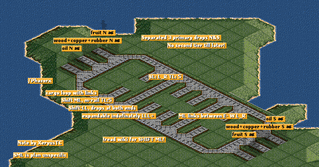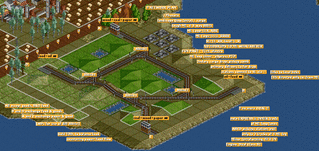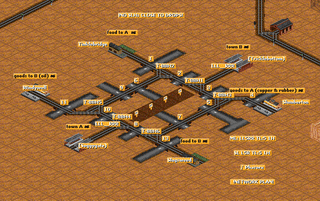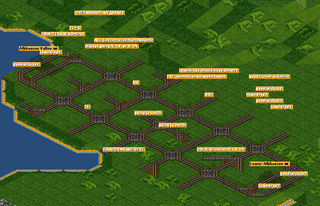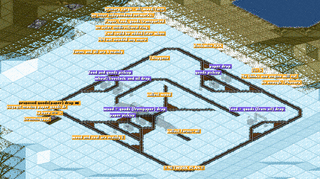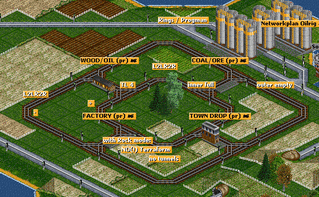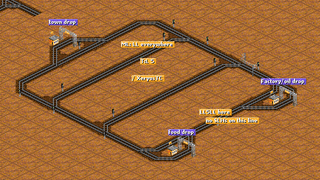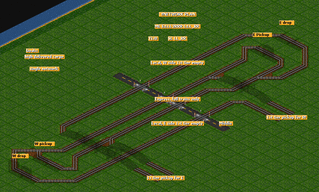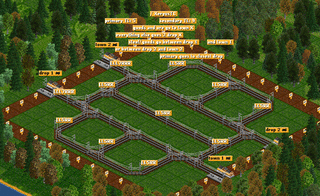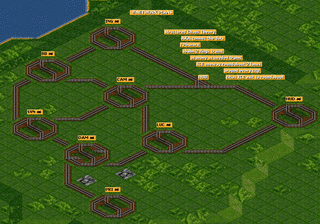Difference between revisions of "Planning"
From #openttdcoop wiki
m |
m (→Implementation) |
||
| (12 intermediate revisions by 4 users not shown) | |||
| Line 1: | Line 1: | ||
| − | Coordination is very important for cooperative gameplay since the goals and implementation tactics are meant to be shared | + | Coordination is very important for cooperative gameplay since the goals and implementation tactics are meant to be shared among all participants. The planning stage of game is the time to lay a good foundation for prolonged and interesting gameplay, where the final result is achieved by combined activity of all players. Planning does take some skill and experience, and should be taken a serious task and with responsibility for future development. It should provide detailed description of what and how is to be achieved. |
==Studying the map== | ==Studying the map== | ||
| − | There is no basic "best strategy" for all situations. All games are very circumstantial, environment dependent, have different focuses. Even for targeted games, when a particular scenario or game preconditions are used, it still remains very open ended and | + | There is no basic "best strategy" for all situations. All games are very circumstantial, environment-dependent, and have different focuses. Even for targeted games, when a particular scenario or game preconditions are used, it still remains very open-ended and a successful result can be achieved by many ways. Thus, it is very important to explore the map and foresee future development and implementation, ensuring that it is possible to achieve the goals that are set. Some layouts are only applicable to certain cases and various types of networks deal with landscape in different fashions. It is very important to keep in mind that it is not that landscape is to be altered to fit the idea of the plan, but vice versa—the plan must adhere to circumstances. |
| − | == | + | ==Defining main elements== |
| − | All plans have certain main elements which predefine the plan's foundation | + | All plans have certain main elements which predefine the plan's foundation. |
| − | + | ||
| − | ; Game type : Global [[ | + | These are: |
| − | ; Goals/focus : Narrowing down the type to a particular | + | ; Game type : Global [[Game types]] (i.e.: PAX, Cargo, SRNW etc.) |
| − | ; Network type : Basic rules, describing type of lines used (perhaps: ''plain'', ''segregated'', ''distributed'', ''shifting'' ) and track width, along with details (such as: '' | + | ; Goals/focus : Narrowing down the type to a particular point (i.e.: ''flow'/capacity', ''speed'', ''second tier saturation'', ''connecting something'', etc.) |
| − | ; Network layout : That controls shape of lines and defined by major stations' requirements. | + | ; Network type : Basic rules, describing type of lines used (perhaps: ''plain'', ''segregated'', ''distributed'', ''shifting'' ) and track width, along with details (such as: ''prioritised 2nd tier', ''none blocking mergers only'', ''expandable to ...'' etc.) |
| − | ; Perks : anything what is out of ordinary and not | + | ; Network layout : That controls shape of lines and defined by major stations' requirements. Should be done in some illustrated form or shape, providing enough details to show key points of particular layout. |
| + | ; Perks : anything what is out of ordinary and not generally applicable to described conditions (i.e.: ''steam only'', ''no terraforming'', ''avoid coal'', ''save all trees'') | ||
==Sharing ideas== | ==Sharing ideas== | ||
| − | It is possible | + | It is possible that there are already plans being discussed or that some are made, in which case it would make sense to comprehend them and understand key elements and differences. Presenting many plans with differences only in directions of tracks or train length used is quite pointless. It would be better to discuss with the author possible changes and make corrections to the existing plan if they are considered as useful after coming to consensus. Plans as well as the game itself can be result of collaboration and shaping the ideas based on experience of different players. However, please make sure to suggest changes rather than insist upon them. |
| − | == | + | ==Planning== |
| − | Usually, there is a remote spot on the map somewhere with sign " !!NETWORK PLANS" next to it. This is designated | + | Usually, there is a remote spot on the map somewhere with sign " !!NETWORK PLANS" next to it. This is designated for laying out proposed plans. If there is no area marked in this way, feel free to create one. Bear in mind that plans are meant to last the whole game and selecting densely populated areas makes very little sense; typically remote areas such as corners and edges of map, with even or gently rolling terrain are the best spots. |
| − | When creating a plan | + | When creating a plan, allocate yourself enough space and try not to interfere with other people's work. Make sure to state as many details as possible to make the plan clear for others (separation between primary/secondary, type of network and width, train lengths etc.). Major elements design can also be noted in case if it is not clear from visual layout. Make sure the plan is comprehensive and covers all/most game aspects. Don't forget to title and sign it, as well as to add it to voting board if one is there already. |
| − | After the core of your plan is done | + | After the core of your plan is done, listen for critique and constructive comments, be patient for more plans to appear, and wait until voting is finished. It is quite common for the planning phase to take a long time simply because of different people's schedules and other limitations. |
| − | ==Understanding | + | ==Understanding complexity== |
| − | As an author of a plan you are responsible for covering many aspects in design and location of key elements (be it a hub station or location of a drop). A good plan should present an opportunity for many players to have their input | + | As an author of a plan you are responsible for covering many aspects in design and location of key elements (be it a hub station or the location of a drop). A good plan should present an opportunity for many players to have their input useful for achieving the goal. It should not be overly complex or simply impossible but have various challenges for a variety of skill levels. It should also withstand the test of time. In many cases planned expandability saves the day by turning tedious upgrades into a set of doable tasks with little to no interference to the existing network. |
==Implementation== | ==Implementation== | ||
| − | In case | + | In case your plan is chosen (and that is bound to happen sometime), as the author you are encouraged to provide as much help as possible to execute the plan. The creator of the selected plan takes a guiding role of chief engineer, answering questions and being a source of wisdom when unforeseen challenges arise. |
| − | It | + | It helps greatly for proper implementation to have predefined locations for major nodes of the network as well as other important elements. Selecting placement for these, by putting signs in desired places, essentially charts the map to meet the plan's requirements. Being the author does not mean that it is totally up to you to create the whole network, but playing a key role in creation process is expected. At the same time let others help you to "get there:" it will be faster and more entertaining as the joint effort of many—that's what #openttdcoop is about, after all! |
==Modification and corrections== | ==Modification and corrections== | ||
| − | As time goes, it is quite possible | + | As time goes, it is quite possible that a need for reform or alteration is required due to change in environment, implementation limitations or unforeseen roadblocks. In the event that such drawbacks are observed, it is imperative to quickly react and modify the plan to satisfy new needs. Along with being ''proactive'' and trying to ensure the future of the game, authors should also try to be ''reactive'' to ongoing development. Other players can provide valuable input which can ease extreme challenges and help avoid known pitfalls. Sometimes there are several approaches that can be taken and it is up to author to consider alternatives and make wise choices and introduce corrections to the plan. |
==Examples== | ==Examples== | ||
Latest revision as of 03:44, 1 May 2014
Coordination is very important for cooperative gameplay since the goals and implementation tactics are meant to be shared among all participants. The planning stage of game is the time to lay a good foundation for prolonged and interesting gameplay, where the final result is achieved by combined activity of all players. Planning does take some skill and experience, and should be taken a serious task and with responsibility for future development. It should provide detailed description of what and how is to be achieved.
Contents
Studying the map
There is no basic "best strategy" for all situations. All games are very circumstantial, environment-dependent, and have different focuses. Even for targeted games, when a particular scenario or game preconditions are used, it still remains very open-ended and a successful result can be achieved by many ways. Thus, it is very important to explore the map and foresee future development and implementation, ensuring that it is possible to achieve the goals that are set. Some layouts are only applicable to certain cases and various types of networks deal with landscape in different fashions. It is very important to keep in mind that it is not that landscape is to be altered to fit the idea of the plan, but vice versa—the plan must adhere to circumstances.
Defining main elements
All plans have certain main elements which predefine the plan's foundation.
These are:
- Game type
- Global Game types (i.e.: PAX, Cargo, SRNW etc.)
- Goals/focus
- Narrowing down the type to a particular point (i.e.: flow'/capacity', speed, second tier saturation, connecting something, etc.)
- Network type
- Basic rules, describing type of lines used (perhaps: plain, segregated, distributed, shifting ) and track width, along with details (such as: prioritised 2nd tier', none blocking mergers only, expandable to ... etc.)
- Network layout
- That controls shape of lines and defined by major stations' requirements. Should be done in some illustrated form or shape, providing enough details to show key points of particular layout.
- Perks
- anything what is out of ordinary and not generally applicable to described conditions (i.e.: steam only, no terraforming, avoid coal, save all trees)
Sharing ideas
It is possible that there are already plans being discussed or that some are made, in which case it would make sense to comprehend them and understand key elements and differences. Presenting many plans with differences only in directions of tracks or train length used is quite pointless. It would be better to discuss with the author possible changes and make corrections to the existing plan if they are considered as useful after coming to consensus. Plans as well as the game itself can be result of collaboration and shaping the ideas based on experience of different players. However, please make sure to suggest changes rather than insist upon them.
Planning
Usually, there is a remote spot on the map somewhere with sign " !!NETWORK PLANS" next to it. This is designated for laying out proposed plans. If there is no area marked in this way, feel free to create one. Bear in mind that plans are meant to last the whole game and selecting densely populated areas makes very little sense; typically remote areas such as corners and edges of map, with even or gently rolling terrain are the best spots.
When creating a plan, allocate yourself enough space and try not to interfere with other people's work. Make sure to state as many details as possible to make the plan clear for others (separation between primary/secondary, type of network and width, train lengths etc.). Major elements design can also be noted in case if it is not clear from visual layout. Make sure the plan is comprehensive and covers all/most game aspects. Don't forget to title and sign it, as well as to add it to voting board if one is there already.
After the core of your plan is done, listen for critique and constructive comments, be patient for more plans to appear, and wait until voting is finished. It is quite common for the planning phase to take a long time simply because of different people's schedules and other limitations.
Understanding complexity
As an author of a plan you are responsible for covering many aspects in design and location of key elements (be it a hub station or the location of a drop). A good plan should present an opportunity for many players to have their input useful for achieving the goal. It should not be overly complex or simply impossible but have various challenges for a variety of skill levels. It should also withstand the test of time. In many cases planned expandability saves the day by turning tedious upgrades into a set of doable tasks with little to no interference to the existing network.
Implementation
In case your plan is chosen (and that is bound to happen sometime), as the author you are encouraged to provide as much help as possible to execute the plan. The creator of the selected plan takes a guiding role of chief engineer, answering questions and being a source of wisdom when unforeseen challenges arise.
It helps greatly for proper implementation to have predefined locations for major nodes of the network as well as other important elements. Selecting placement for these, by putting signs in desired places, essentially charts the map to meet the plan's requirements. Being the author does not mean that it is totally up to you to create the whole network, but playing a key role in creation process is expected. At the same time let others help you to "get there:" it will be faster and more entertaining as the joint effort of many—that's what #openttdcoop is about, after all!
Modification and corrections
As time goes, it is quite possible that a need for reform or alteration is required due to change in environment, implementation limitations or unforeseen roadblocks. In the event that such drawbacks are observed, it is imperative to quickly react and modify the plan to satisfy new needs. Along with being proactive and trying to ensure the future of the game, authors should also try to be reactive to ongoing development. Other players can provide valuable input which can ease extreme challenges and help avoid known pitfalls. Sometimes there are several approaches that can be taken and it is up to author to consider alternatives and make wise choices and introduce corrections to the plan.
